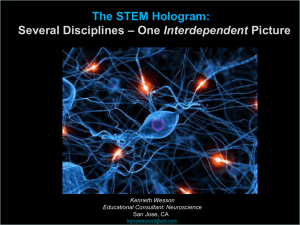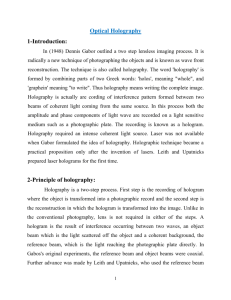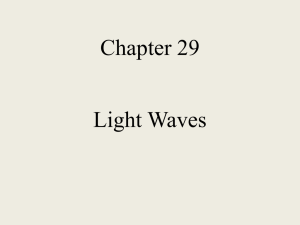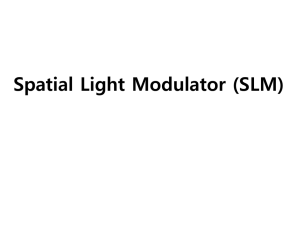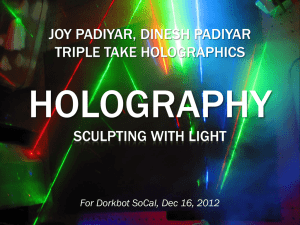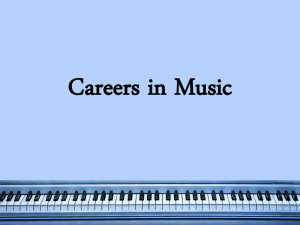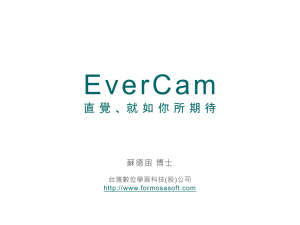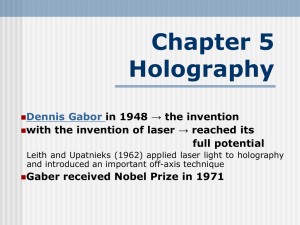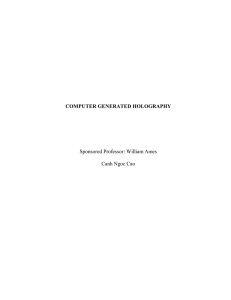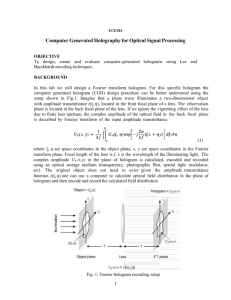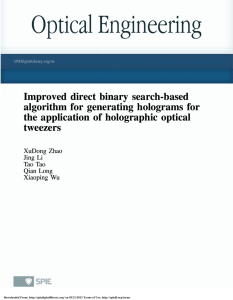File
advertisement
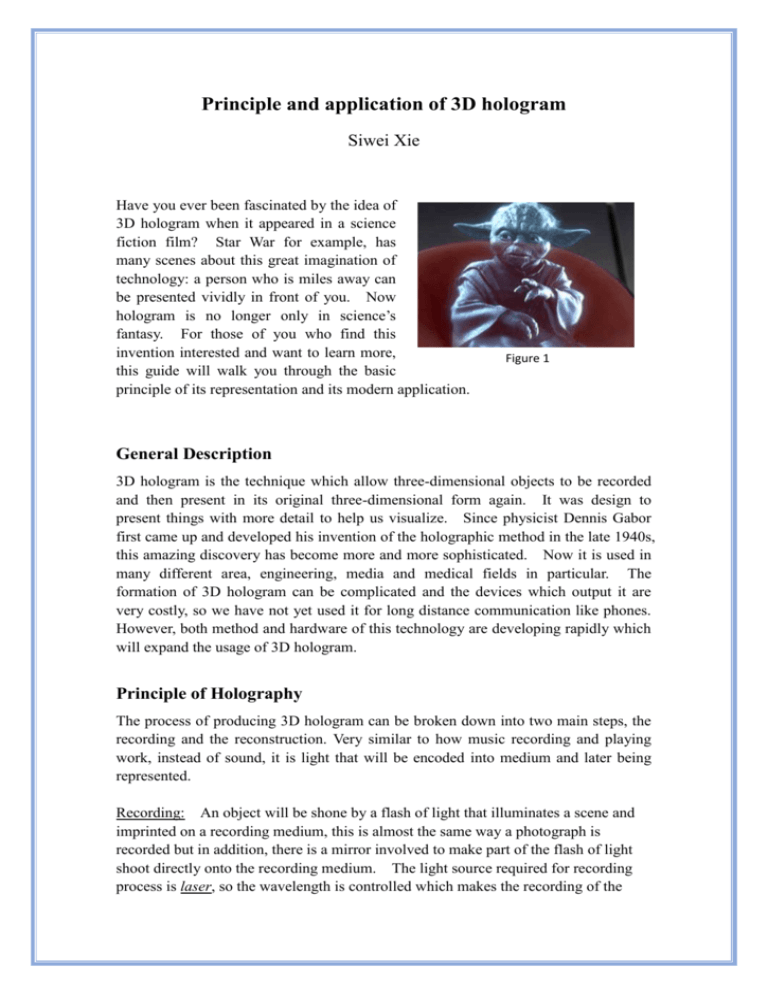
Principle and application of 3D hologram Siwei Xie Have you ever been fascinated by the idea of 3D hologram when it appeared in a science fiction film? Star War for example, has many scenes about this great imagination of technology: a person who is miles away can be presented vividly in front of you. Now hologram is no longer only in science’s fantasy. For those of you who find this invention interested and want to learn more, this guide will walk you through the basic principle of its representation and its modern application. Figure 1 General Description 3D hologram is the technique which allow three-dimensional objects to be recorded and then present in its original three-dimensional form again. It was design to present things with more detail to help us visualize. Since physicist Dennis Gabor first came up and developed his invention of the holographic method in the late 1940s, this amazing discovery has become more and more sophisticated. Now it is used in many different area, engineering, media and medical fields in particular. The formation of 3D hologram can be complicated and the devices which output it are very costly, so we have not yet used it for long distance communication like phones. However, both method and hardware of this technology are developing rapidly which will expand the usage of 3D hologram. Principle of Holography The process of producing 3D hologram can be broken down into two main steps, the recording and the reconstruction. Very similar to how music recording and playing work, instead of sound, it is light that will be encoded into medium and later being represented. Recording: An object will be shone by a flash of light that illuminates a scene and imprinted on a recording medium, this is almost the same way a photograph is recorded but in addition, there is a mirror involved to make part of the flash of light shoot directly onto the recording medium. The light source required for recording process is laser, so the wavelength is controlled which makes the recording of the object looks much similar to the original object. Figure 2 Laser: light amplification by stimulated emission of radiation, so its property can be precisely modified. When the part of the light shoot directly to the recording medium and the part which get to the object intersect with each other, the object imprints onto the recording medium and we got the recording that we need. It seems like a very simple step and can be done by only a few equipment, but as a matter of fact, the requirements of the recording environment and items are very strict. The essential need of laser as light source is mentioned, a place with no lights to place the recording object is also necessary because external light will affect the recording and lead to inaccuracy of presentation. Reconstruction: Once we have the recording of the object to present it back will be the next step. When the hologram plate is illuminated by a laser beam identical to the reference beam which was used to record the hologram, an exact reconstruction of the original object wavefront is obtained. The virtual image on the figure 3 can be presented in many way, usually by a projector. The reconstruction beam is also required to be fixed with its wavelength, otherwise the reconstructed image will not be exactly the same as the original. Figure 3 Items required: That object which is presenting Light source(laser beam) Mirror and photographic plate Recording medium(it can be a film or electrical file) Device to project virtual image Application of 3D hologram 3D hologram is no longer just in fiction, it is wildly used in our life. Being able to present an object this completely proved to be useful in many area, surgeon uses it to perform important procedure, and engineer uses it to create a straightforward three-dimensional image of product. Now after going through how to make 3D holograms, it’s time to show you some modern applications which apply the technology and talk about specific unique properties of hologram. Passport: the United States passport used hologram technology to have pictures on citizen’s passport for the verification. Since the recording process is complicated and varies according to different devices, light source and environment, it is almost impossible to fake a hologram when information of the production have been kept as a secret. To have an exactly same hologram, we need more than just the same original recording object, but also all data during the process, therefore the uniqueness of hologram proved to be useful for personal identification document. Figure 4 3D printer: this is so far the most famous application of hologram, it allows user of the machine to enter a 3D object through computer or other designing device and the printer will produce the complete object by “printing” it. This is amazing because it speeds up the production process by a lot, showed us what we can do if we can product a perfect recording of an object. Computer technology is advanced enough today to allow us use computer software to enter data and numbers to product 3D hologram. We won’t miss details in any angle and this is much straightforward then designing a flat blueprint first. Figure 5 Internal Organs Scanning device: Surgeons benefits a lot from this highly advanced technology of 3D hologram. Instead of using human eyes to judge the status of patient’s organs, this is more accurate and once the scanning is done, doctors are allow to rotate the 3D image freely, so there won’t be a blind spot and the pernicious influence can be eliminate to the minimum. Figure 6 Conclusion: The concept of creating a 3D hologram is simple yet the process is restricted to many factors, very specific environment, items and resources are needed. Technology nowadays is advancing in an incredible speed, this will eventually lead to a more widely usage of 3D hologram, I believe this great invention will development from just a creative way to communicate to many other great works in the future. References and figures http://en.wikipedia.org/wiki/Holography http://www.popsci.com/category/tags/holograms http://musion.co.uk/#!/products-services/eyeliner Figure 1: http://blog.highersitesgroup.com/2014/02/cool-tech-for-2014/ Figure 2: http://en.wikipedia.org/wiki/File:Holograph-record.svg Figure 3: http://en.wikipedia.org/wiki/File:Holography-reconstruct.svg Figure 4: http://www.messinglawoffices.com/passport.aspx Figure 5: http://www.engadget.com/2012/09/26/form-1-delivers-high-end-3d-printing-for-an-affordable-p rice/ Figure 6: http://blog.applysci.com/?p=1442
